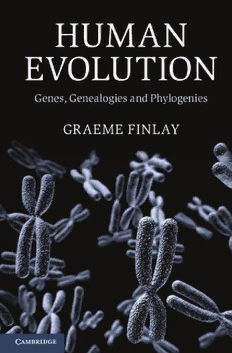
Human evolution genes, genealogies and phylogenies PDF
Preview Human evolution genes, genealogies and phylogenies
Human Evolution Genes, Genealogies and Phylogenies Controversy over human evolution remains widespread. However, the Human Genome Project and genetic sequencing of many other species have provided myriad precise and unambiguous genetic markers that establish our evolutionary relationships with other mammals. Human Evolution identifies and explains these identifiable rare and complex markers, including endogenous retroviruses, genome-m odifying transposable elements, gene- disabling mutations, segmental duplications, and gene- enabling mutations. The new genetic tools also provide fascinating insights into when, and how, many features of human biology arose: from aspects of placental structure; vitamin C- dependence and trichromatic vision; to tendencies to gout, cardiovascular disease and cancer. Bringing together a decade’s worth of research and tying it together to provide an overwhelming argument for the mammalian ancestry of the human species, this book will be of interest to professional scientists and students in both the biological and biomedical sciences. Graeme Finlay is Senior lecturer in Scientific Pathology at the Department of molecular medicine and Pathology, and Honorary Senior research Fellow at the auckland Cancer Society research Centre, University of auckland, new Zealand. Human Evolution Genes, Genealogies and Phylogenies Graeme Finlay Department of Molecular Medicine and Pathology, Auckland Cancer Society Research Centre, University of Auckland, New Zealand University Printing House, Cambridge CB2 8BS, United Kingdom Published in the United States of america by Cambridge University Press, new york Cambridge University Press is part of the University of Cambridge. it furthers the University’s mission by disseminating knowledge in the pursuit of education, learning and research at the highest international levels of excellence. www.cambridge.org information on this title: www.cambridge.org/9781107040120 © G. Finlay 2013 This publication is in copyright. Subject to statutory exception and to the provisions of relevant collective licensing agreements, no reproduction of any part may take place without the written permission of Cambridge University Press. First published 2013 Printed in the United Kingdom by Clays, St ives plc A catalogue record for this publication is available from the British Library Library of Congress Cataloguing in Publication data Finlay, Graeme, 1953– Human evolution : genes, genealogies and phylogenies / Graeme Finlay, Department of molecular medicine and Pathology, auckland Cancer Society research Centre, University of auckland, new Zealand. pages cm includes bibliographical references and index. iSBn 978-1-107-04012-0 (hardback) 1. Human evolution. 2. Human population genetics. 3. evolutionary genetics. 4. Genetic genealogy. i. Title. Gn281.F54 2013 599.93′8–dc23 2013015863 iSBn 978-1 - 107-0 4012- 0 Hardback Cambridge University Press has no responsibility for the persistence or accuracy of Urls for external or third-p arty internet websites referred to in this publication, and does not guarantee that any content on such websites is, or will remain, accurate or appropriate. Contents Preface page ix Prologue 1 1 Darwin’s science 2 2 Genetics arrives on the scene 4 3 Theological responses to Darwin 6 4 interpretations of evolution today 10 5 evolution and the genome revolution 12 6 The scope of this book 18 1 retroviral genealogy 21 1.1 The retroviral life cycle 22 1.2 retroviruses and the monoclonality of tumours 26 1.3 endogenous retroviruses and the monophylicity of species 32 1.4 natural selection at work: genes from junk 47 1.4.1 erVs and the placenta 48 1.4.2 erVs that contribute to gene content 55 1.5 natural selection at work: regulatory networks 56 1.6 are there alternative interpretations of the data? 58 1.7 Conclusion: a definitive retroviral genealogy for simian primates 68 2 Jumping genealogy 70 2.1 The activities of retroelements 73 2.1.1 line- 1 elements 74 2.1.2 alu elements 77 2.1.3 SVa elements 78 v vi Contents 2.2 retroelements and human disease 78 2.3 retroelements and primate evolution 84 2.3.1 line- 1 elements 84 2.3.2 alu elements 88 2.3.3 retroelements and phylogeny: validation 97 2.4 more ancient elements and mammalian evolution 101 2.4.1 euarchontoglires: the primate–rodent group 103 2.4.2 Boreoeutheria: incorporating the primate–rodent group and the laurasian beasts 105 2.4.3 eutheria 107 2.4.4 mammals 111 2.4.5 Te stories on other branches of the tree of life 114 2.5 exaptation of Tes 116 2.5.1 raw material for new genes 117 2.5.2 raw material for new exons 118 2.5.3 raw material for new regulatory modules 120 2.6 The evolutionary significance of Tes 124 2.6.1 Tes, genomic reorganisation and speciation 124 2.6.2 Tes and evolvability 128 3 Pseudogenealogy 132 3.1 mutations and the monoclonal origins of cancers 135 3.2 Old scars on Dna 138 3.2.1 Classical marks of nHeJ 139 3.2.2 lines and alus 141 3.2.3 nUmTs 142 3.2.4 interstitial telomeric sequences 145 3.3 Pseudogenes 148 3.3.1 Human- specific pseudogenes 152 3.3.2 ape-s pecific pseudogenes 157 3.3.3 Simian- specific pseudogenes 163 3.3.4 Pseudogenes and sensory perception 172 3.3.5 Pseudogenes from further afield 180 3.4 Processed pseudogenes 183 Contents vii 3.5 rare mutations that conserve protein- coding function 187 3.6 Conclusions 189 4 The origins of new genes 194 4.1 new genes in cancer 195 4.2 Copy number variants 198 4.3 Segmental duplications 201 4.3.1 Some early pointers 201 4.3.2 Systematic studies of SDs 203 4.4 new genes 206 4.4.1 reproduction 207 4.4.2 Hydrolytic enzymes 218 4.4.3 neural systems 220 4.4.4 Blood 224 4.4.5 immunity 228 4.4.6 master regulators of the genome 236 4.5 retrogenealogy 238 4.5.1 reverse- transcribed genes in primates 239 4.5.2 reverse- transcribed genes in mammals 246 4.6 Dna transposons 249 4.7 De novo origins of genes 254 4.8 Generating genes and genealogies 261 epilogue: what really makes us human 265 1 immune systems 267 2 nervous systems 270 2.1 Critical periods 272 2.2 learning from neglect 273 3 Features of personhood 277 4 Stories and narrative identity 279 References 284 Index 351
